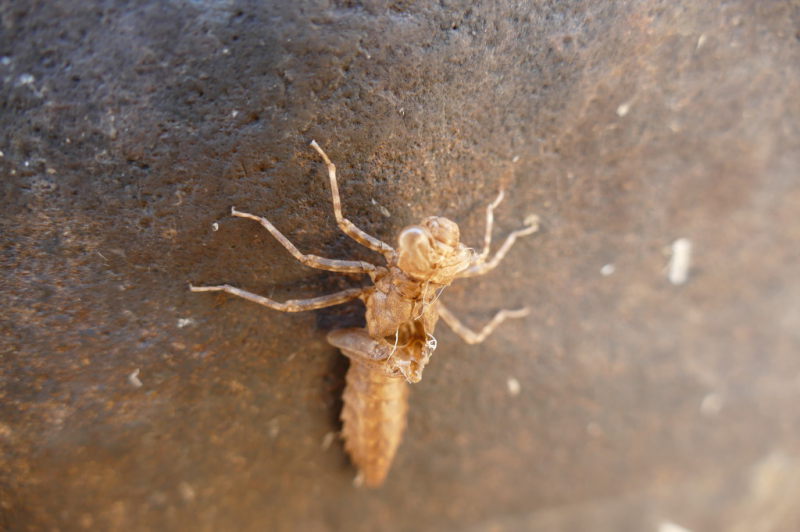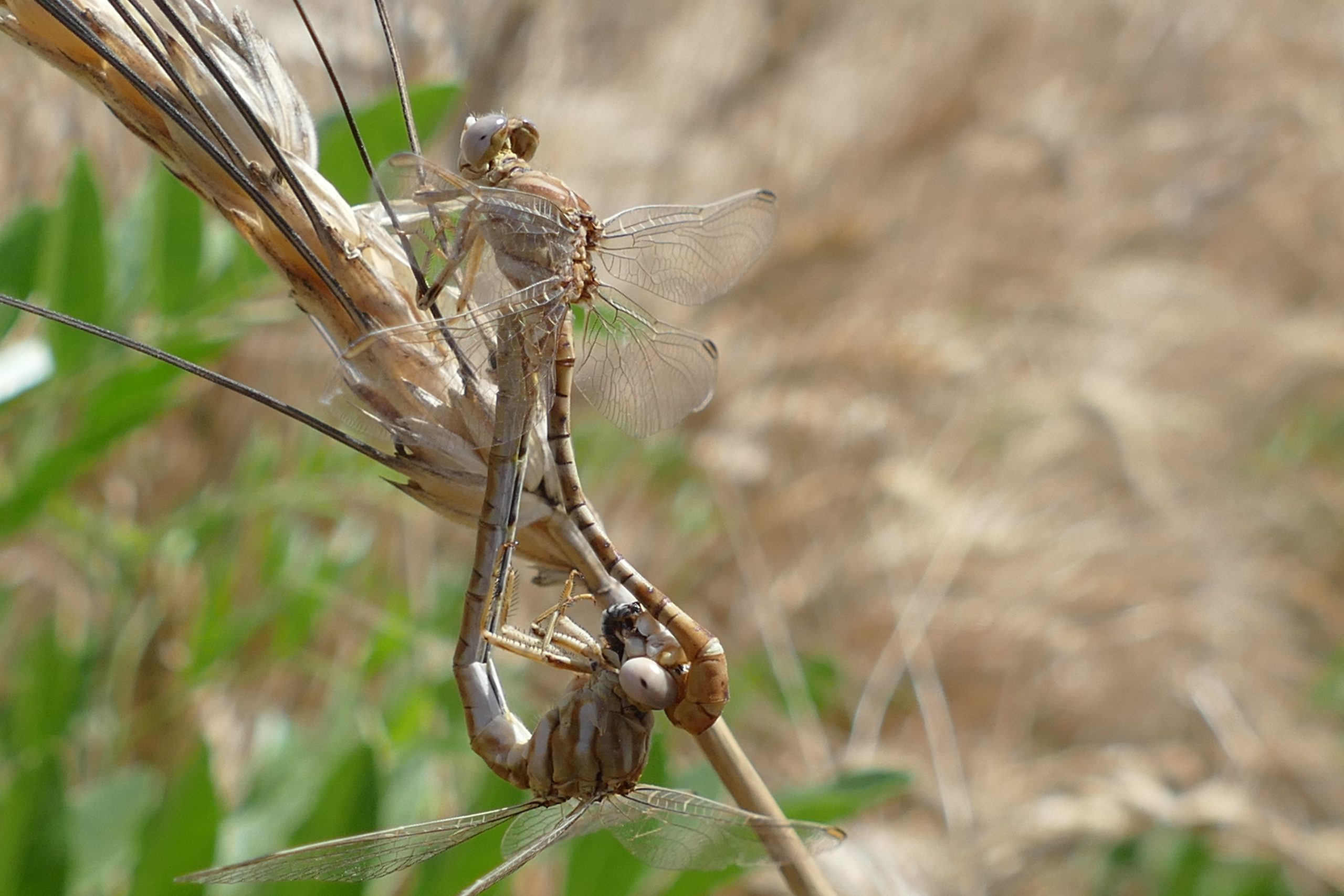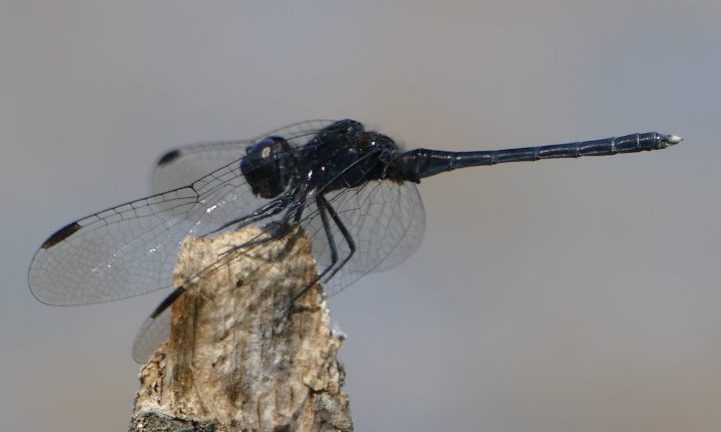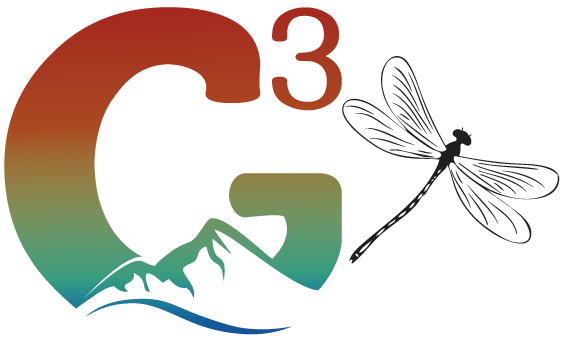
Dragonflies of Andalusia
Southern species exclusive within Europe – an invitation to complete your field guide.
Dragonflies or odonates are insects with elongated and often vividly colored bodies, endowed with two pairs of large wings and bulky eyes, which patrol the aquatic environments on hot days like no other insect … The larvae are aquatic and provided with a prehensile “mask” to capture its prey.
Andalusia has 62 species of odonates, being the Iberian bluetail (Ischnura graellsii), an Iberian endemism that extends slightly in France, the most common species in the entire peninsula.
Andalusia is also the gateway to the African species that colonize Europe. We can mention the violet dropwing (Trithemis annulata) and the orange-winged dropwing (Trithemis kirbyi), two species with spectacular colors and easy to observe.
Colonization start |
African (or Asiatic*) species |
| 2007 | Trithemis kirbyi |
| 1978 | Trithemis annulata |
| 1966 | Orthetrum trinacria |
| 1957, 1961 | Brachythemis impartita |
| 1904, 1935, 1942 | Diplacodes lefebvrii |
| Presence detected in the 19th century, distribution restricted to the Iberian Peninsula in Europe | Sympetrum sinaiticum |
| Paragomphus genei | |
| Orthetrum chrysostigma | |
| Selysiothemis nigra* | |
| Zygonyx torridus | |
| Presence detected in the 19th century, wide distribution in Europe | Anax imperator |
| Anax ephippiger | |
| Crocothemis erythraea | |
| Sympetrum fonscolombii |

Dragonflies of Andalusia: pair of Epaulet skimmer (Orthetrum chrysostigma), a very common species at South Iberian streams.

The Iberian bluetail (Ischnura graellsii), one of the most frequent species of the Iberian Peninsula and almost endemic to this territory.
Andalusia is one of the most popular European destinations to observe odonata.


A large pincertail (Onychogomphus uncatus) that has just emerged on an Andalusian river.

Western spectre (Boyeria irene) exuvia, easy to find and to identify in the field, especially at well preserved low-mountain streams.
In the European context, the Iberian Peninsula, and in particular Andalusia, is home to large populations of odonates of ordinary continual waters, the most sensitive to pollution. Also keep in mind that the Genal and Hozgarganta rivers are reputed to be the last wild rivers of Andalusia and the streams of the Costa del Sol that house an exceptional aquatic biodiversity.
The area is home to streams characterized by their low flow and very mild water temperatures, very favorable conditions for species specialized in lotic ecosystems: copper demoiselle (Calopteryx haemorrhoidalis), orange Featherleg (Platycnemis acutipennis), western spectre (Boyeria irene), three species of Gomphus and three species of Onychogomphus. More rare and endangered: the orange-spotted emerald (Oxygastra curtisii) and the splendid cruiser (Macromia splendens), the latter being difficult to observe due to its behavior. Add ponds and lagoons that offer a habitat and a variety of different species.
Other species, present in the sector and whose distribution is limited in Europe (and even within Spain) are: ringed cascader (Zygonyx torridus), black percher (Diplacodes lefebvrii), faded pincertail (Onychogomphus costae), common hooktail (Paragomphus genei), epaulet skimmer (Orthetrum chrysostigma), yellow-Veined skimmer (Orthetrum nitidinerve), long skimmer (Orthetrum trinacria), desert darter (Sympetrum sinaiticum), northern banded groundling (Brachythemys impartita), black pennant (Selysiothemis nigra). These species are often restricted to specific localities and habitats, which can hinder their sightings.
Running waters
Habitat of “lotic” species (e.g. gomphids, demoiselles) typical of streams and rivers with fast flowing waters (cold temperatures, high oxygen) and which larvae hidde within gravels substrate or under stones and often developpe over various years.
Slow flowing waters
Habitat of dragonflies more typical of shallow running waters (skimmers, coenagrionids damselflies), which larvae are less adapted to resist fast currents. Biotopes often with presence of aquatic vegetation, high oxygen and cool temperatures. Special cases: Splendid cruiser (Macromia splendens) found shelter at large permanent pools within mediterranean rivers ; Faded pincertail (Onychogomphus costae) lives in the largest Andalusian rivers.
Still waters
Species (darters, hawkers) inhabiting basins without water flow (ponds, lagoons), with preferences either for permanent, semi-permanent or temporary waters, depending on larval growth and colonisation.
Opportunistic species
Dragonflies prefering still waters (libellulids), although their very strong colonization potential and short larval development allow them to occupy a broad range of habitats, for example slow flowing section of streams.

The Iberian bluetail (Ischnura graellsii), one of the most frequent species of the Iberian Peninsula and almost endemic to this territory.
Dragonflies or odonates are insects with elongated and often vividly colored bodies, endowed with two pairs of large wings and bulky eyes, which patrol the aquatic environments on hot days like no other insect … The larvae are aquatic and provided with a prehensile “mask” to capture its prey.
Andalusia has 62 species of odonates, being the Iberian bluetail (Ischnura graellsii), an Iberian endemism that extends slightly in France, the most common species in the entire peninsula.

Dragonflies of Andalusia: pair of Epaulet skimmer (Orthetrum chrysostigma), a very common species at South Iberian streams.
Andalusia is also the gateway to the African species that colonize Europe. We can mention the violet dropwing (Trithemis annulata) and the orange-winged dropwing (Trithemis kirbyi), two species with spectacular colors and easy to observe.
Colonization start |
African (or Asiatic*) species |
| 2007 | Trithemis kirbyi |
| 1978 | Trithemis annulata |
| 1966 | Orthetrum trinacria |
| 1957, 1961 | Brachythemis impartita |
| 1904, 1935, 1942 | Diplacodes lefebvrii |
| Presence detected in the 19th century, distribution restricted to the Iberian Peninsula in Europe | Sympetrum sinaiticum |
| Paragomphus genei | |
| Orthetrum chrysostigma | |
| Selysiothemis nigra* | |
| Zygonyx torridus | |
| Presence detected in the 19th century, wide distribution in Europe | Anax imperator |
| Anax ephippiger | |
| Crocothemis erythraea | |
| Sympetrum fonscolombii |
Andalusia is one of the most popular European destinations to observe odonata.
In the European context, the Iberian Peninsula, and in particular Andalusia, is home to large populations of odonates of ordinary continual waters, the most sensitive to pollution. Also keep in mind that the Genal and Hozgarganta rivers are reputed to be the last wild rivers of Andalusia and the streams of the Costa del Sol that house an exceptional aquatic biodiversity.

A large pincertail (Onychogomphus uncatus) that has just emerged on an Andalusian river.
The area is home to streams characterized by their low flow and very mild water temperatures, very favorable conditions for species specialized in lotic ecosystems: copper demoiselle (Calopteryx haemorrhoidalis), orange Featherleg (Platycnemis acutipennis), western spectre (Boyeria irene), three species of Gomphus and three species of Onychogomphus. More rare and endangered: the orange-spotted emerald (Oxygastra curtisii) and the splendid cruiser (Macromia splendens), the latter being difficult to observe due to its behavior. Add ponds and lagoons that offer a habitat and a variety of different species.

Western spectre (Boyeria irene) exuvia, easy to find and to identify in the field, especially at well preserved low-mountain streams.
Other species, present in the sector and whose distribution is limited in Europe (and even within Spain) are: ringed cascader (Zygonyx torridus), black percher (Diplacodes lefebvrii), faded pincertail (Onychogomphus costae), common hooktail (Paragomphus genei), epaulet skimmer (Orthetrum chrysostigma), yellow-Veined skimmer (Orthetrum nitidinerve), long skimmer (Orthetrum trinacria), desert darter (Sympetrum sinaiticum), northern banded groundling (Brachythemys impartita), black pennant (Selysiothemis nigra). These species are often restricted to specific localities and habitats, which can hinder their sightings.
Running waters

Habitat of “lotic” species (e.g. gomphids, demoiselles) typical of streams and rivers with fast flowing waters (cold temperatures, high oxygen) and which larvae hidde within gravels substrate or under stones and often developpe over various years.
Slow flowing waters

Habitat of dragonflies more typical of shallow running waters (skimmers, coenagrionids damselflies), which larvae are less adapted to resist fast currents. Biotopes often with presence of aquatic vegetation, high oxygen and cool temperatures. Special cases: Splendid cruiser (Macromia splendens) found shelter at large permanent pools within mediterranean rivers ; Faded pincertail (Onychogomphus costae) lives in the largest Andalusian rivers.
Still waters

Species (darters, hawkers) inhabiting basins without water flow (ponds, lagoons), with preferences either for permanent, semi-permanent or temporary waters, depending on larval growth and colonisation.
Opportunistic species

Dragonflies prefering still waters (libellulids), although their very strong colonization potential and short larval development allow them to occupy a broad range of habitats, for example slow flowing section of streams.

Dragonflies:list of species present in Andalusia
# |
Group |
Family |
Species |
Common name |
Identification (adult male) |
Main distribution |
Prefered habitat |
IUCN Andalucia (2008) |
| 1 | Zygoptera | Calopterygidae | Calopteryx haemorrhoidalis | Copper demoiselle | Unmistakable | SW Palearctic | Running waters | |
| 2 | – | Calopterygidae | Calopteryx virgo meridionalis | Beautiful demoiselle |
Unmistakable | SW Palearctic |
Running waters | |
| 3 | – | Calopterygidae | Calopteryx xanthostoma | Western demoiselle |
Unmistakable | Iberia, France | Running waters | VU |
| 4 | – | Coenagrionidae | Ceriagrion tenellum | Small red damsel | Easy | W Palearctic | Slow flowing waters | |
| 5 | – | Coenagrionidae | Coenagrion caerulescens | Mediterranean bluet | Tricky | SW Palearctic | Slow flowing waters | VU |
| 6 | – | Coenagrionidae | Coenagrion mercuriale | Mercury bluet | Tricky | SW Palearctic | Slow flowing waters | VU |
| 7 | – | Coenagrionidae | Coenagrion puella | Azure bluet |
Tricky | Palearctic | Still waters | EXT? VU |
| 8 | – | Coenagrionidae | Coenagrion scitulum | Dainty bluet | Tricky | Palearctic | Still waters | VU |
| 9 | – | Coenagrionidae | Enallagma cyathigerum | Common bluet | Tricky | Palearctic | Still waters | |
| 10 | – | Coenagrionidae | Erythromma lindenii | Blue-eye | Easy | W Palearctic | Opportunistic | |
| 11 | – | Coenagrionidae | Erythromma viridulum | Small Redeye | Easy | W Palearctic | Still waters | |
| 12 | – | Coenagrionidae | Ischnura graellsii | Iberian bluetail |
Easy | Iberia, Maghreb | Opportunistic | |
| 13 | – | Coenagrionidae | Ischnura pumilio | Small bluetail |
Tricky | Palearctic | Still waters | |
| 14 | – | Coenagrionidae | Pyrrhosoma nymphula | Large red damsel | Easy | W Palearctic | Slow flowing waters | |
| 15 | – | Lestidae | Chalcolestes viridis | Willow spreadwing |
Easy | W Palearctic |
Opportunistic | |
| 16 | – | Lestidae | Lestes barbarus | Migrant spreadwing |
Tricky | Palearctic | Still waters | |
| 17 | – | Lestidae | Lestes dryas | Robust spreadwing | Tricky | Palearctic, Nearctic | Still waters | VU |
| 18 | – | Lestidae | Lestes macrostigma | Dark spreadwing | Unmistakable | Palearctic | Still waters | VU |
| 19 | – | Lestidae | Lestes virens virens | Small spreadwing |
Tricky | Palearctic | Still waters | |
| 20 | – | Lestidae | Sympecma fusca | Common winter damsel | Unmistakable | Palearctic | Opportunistic | |
| 21 | – | Platycnemididae | Platycnemis acutipennis | Orange featherleg | Unmistakable | Iberia, France | Slow flowing waters | |
| 22 | – | Platycnemididae | Platycnemis latipes | White featherleg | Unmistakable | Iberia, France | Opportunistic | |
| 23 | Anisoptera | Aeshnidae | Aeshna affinis | Blue-eyed hawker | Tricky | Palearctic | Still waters | DD |
| 24 | – | Aeshnidae | Aeshna cyanea | Blue hawker | Easy | W Palearctic | Still waters | |
| 25 | – | Aeshnidae | Aeshna isoceles | Green-eyed hawker | Unmistakable | W Palearctic | Still waters | EXT? VU |
| 26 | – | Aeshnidae | Aeshna mixta | Migrant hawker | Tricky | Palearctic | Still waters | |
| 27 | – | Aeshnidae | Anax ephippiger | Vagrant Emperor | Easy | Africa | Still waters | |
| 28 | – | Aeshnidae | Anax imperator | Blue Emperor | Easy | Africa, Palearctic | Opportunistic | |
| 29 | – | Aeshnidae | Anax parthenope | Lesser Emperor | Easy | Palearctic, Indomalaya | Opportunistic | |
| 30 | – | Aeshnidae | Boyeria irene | Western spectre | Unmistakable | SW Palearctic | Running waters | |
| 31 | – | Aeshnidae | Brachytron pratense | Hairy dragonfly | Easy | W Palearctic | Still waters | EXT? EN |
| 32 | – | Cordulegastridae | Cordulegaster boltonii | Common goldenring | Easy | W Palearctic | Running waters | |
| 33 | – | Macromiidae | Macromia splendens | Splendid cruiser | Easy | Iberia, France | Slow flowing waters | CR |
| 34 | – | Corduliidae | Oxygastra curtisii | Orange-spotted emerald | Unmistakable | SW Palearctic | Slow flowing waters | EN |
| 35 | – | Gomphidae | Gomphus graslinii | Pronged clubtail | Tricky | Iberia, France | Running waters | EN |
| 36 | – | Gomphidae | Gomphus pulchellus | Western clubtail | Tricky | SW Palearctic | Still waters | |
| 37 | – | Gomphidae | Gomphus simillimus |
Yellow clubtail | Tricky | SW Palearctic | Running waters | VU |
| 38 | – | Gomphidae | Onychogomphus costae | Faded pincertail | Unmistakable | Iberia, Maghreb | Slow flowing waters | |
| 39 | – | Gomphidae | Onychogomphus forcipatus unguiculatus | Small pincertail | Tricky | W Palearctic | Running waters | |
| 40 | – | Gomphidae | Onychogomphus uncatus | Large pincertail | Tricky | SW Palearctic | Running waters | DD |
| 41 | – | Gomphidae | Paragomphus genei | Green hooktail | Unmistakable | Africa | Slow flowing waters | |
| 42 | – | Libellulidae | Brachythemis impartita | Northern banded groundling | Unmistakable | Africa | Still waters | |
| 43 | – | Libellulidae | Crocothemis erythraea | Broad scarlet | Easy | Africa, Palearctic, Indomalaya | Opportunistic | |
| 44 | – | Libellulidae | Diplacodes lefebvrii | Black percher | Tricky | Africa, Indomalaya | Still waters | |
| 45 | – | Libellulidae | Libellula depressa | Broad-bodied chaser | Unmistakable | Palearctic | Still waters | |
| 46 | – | Libellulidae | Libellula fulva | Blue chaser | Easy | Palearctic | Still waters | EXT? |
| 47 | – | Libellulidae | Libellula quadrimaculata | Four-spotted chaser | Unmistakable | Nearctic, Palearctic | Still waters | DD |
| 48 | – | Libellulidae | Orthetrum brunneum | Southern skimmer | Tricky | Palearctic | Slow flowing waters | |
| 49 | – | Libellulidae | Orthetrum cancellatum | Black-tailed skimmer | Unmistakable | Palearctic | Still waters | |
| 50 | – | Libellulidae | Orthetrum chrysostigma | Epaulet skimmer | Easy | Africa, Iberia, Turkey | Slow flowing waters | |
| 51 | – | Libellulidae | Orthetrum coerulescens | Keeled skimmer | Tricky | Palearctic | Slow flowing waters | |
| 52 | – | Libellulidae | Orthetrum nitidinerve | Yellow-veined skimmer | Easy | Iberia, Maghreb, Sicilia, Sardinia | Slow flowing waters | VU |
| 53 | – | Libellulidae | Orthetrum trinacria | Long skimmer | Easy | Africa, SW Asia | Still waters | |
| 54 | – | Libellulidae | Selysiothemis nigra | Black pennant | Tricky | Asia, Mediterranean | Still waters | |
| 55 | – | Libellulidae | Sympetrum fonscolombii | Red-veined darter | Easy | Africa, Asia, Palearctic | Still waters | |
| 56 | – | Libellulidae | Sympetrum meridionale | Southern darter | Tricky | Palearctic | Still waters | |
| 57 | – | Libellulidae | Sympetrum sanguineum | Ruddy darter | Tricky | Palearctic | Still waters | |
| 58 | – | Libellulidae | Sympetrum sinaiticum | Desert darter | Tricky | Mediterranean | Slow flowing waters | |
| 59 | – | Libellulidae | Sympetrum striolatum | Common darter | Tricky | Palearctic | Opportunistic | |
| 60 | – | Libellulidae | Trithemis annulata | Violet dropwing | Unmistakable | Africa | Opportunistic | |
| 61 | – | Libellulidae | Trithemis kirbyi | Orange-winged dropwing | Unmistakable | Africa | Opportunistic | |
| 62 | – | Libellulidae | Zygonyx torridus | Ringed cascader | Easy | Africa | Running waters | VU |
Notes
IUCN: Extinction risk. LR: Lower Risk. NT: Near Threathened. VU: Vulnerable. EN: Endangered. EX: Extinct.
















0 Comments